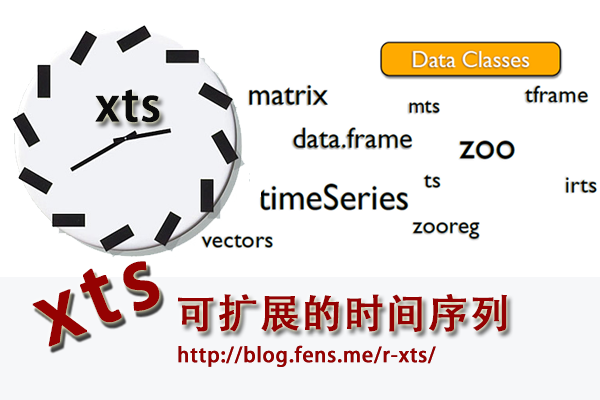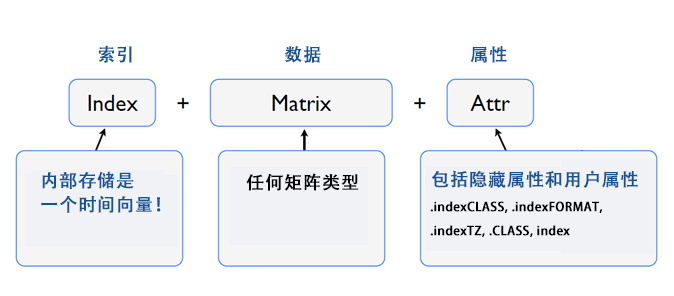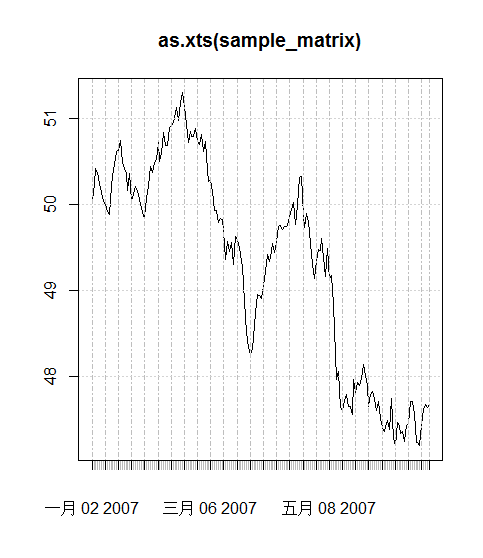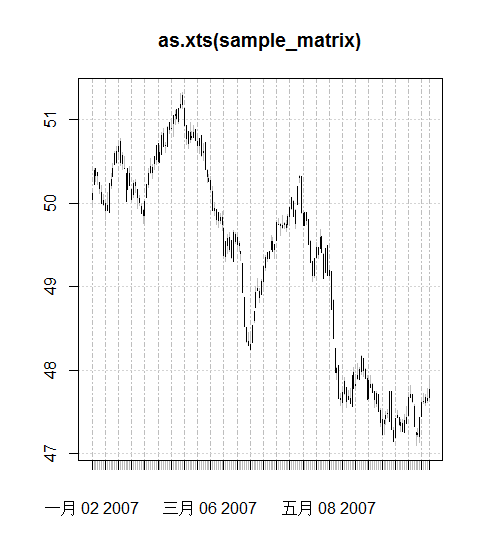R語言學習之
可擴充套件的時間序列xts
R的極客理想系列文章,涵蓋了R的思想,使用,工具,創新等的一系列要點,以我個人的學習和體驗去詮釋R的強大。
R語言作為統計學一門語言,一直在小眾領域閃耀著光芒。直到大資料的爆發,R語言變成了一門炙手可熱的資料分析的利器。隨著越來越多的工程背景的人的加入,R語言的社群在迅速擴大成長。現在已不僅僅是統計領域,教育,銀行,電商,網際網路….都在使用R語言。
要成為有理想的極客,我們不能停留在語法上,要掌握牢固的數學,概率,統計知識,同時還要有創新精神,把R語言發揮到各個領域。讓我們一起動起來吧,開始R的極客理想。
關於作者:
- 張丹(Conan), 程式設計師Java,R,PHP,Javascript
- weibo:@Conan_Z
- email: [email protected]
前言
本文是繼R語言zoo時間序列基礎庫的擴充套件實現。看上去簡單的時間序列,內藏複雜的規律。zoo作為時間序列的基礎庫,是面向通用的設計,可以用來定義股票資料,也可以分析天氣資料。但由於業務行為的不同,我們需要更多的輔助函式,來幫助我們更高效的完成任務。
xts擴充套件了zoo,提供更多的資料處理和資料變換的函式。
目錄
- xts介紹
- xts安裝
- xts資料結構
- xts的API介紹
- xts使用
1. xts介紹
xts是對時間序列資料(zoo)的一種擴充套件實現,目標是為了統一時間序列的操作介面。實際上,xts型別繼承了zoo型別,豐富了時間序列資料處理的函式,API定義更貼近使用者,更實用,更簡單!
2. xts安裝
系統環境
- Win7 64bit
- R: 3.0.1 x86_64-w64-mingw32/x64 b4bit
xts安裝
> install.packages("xts") also installing the dependency ‘zoo’ trying URL 'http://mirror.bjtu.edu.cn/cran/bin/windows/contrib/3.0/zoo_1.7-10.zip' Content type 'application/zip' length 875046 bytes (854 Kb) opened URL downloaded 854 Kb trying URL 'http://mirror.bjtu.edu.cn/cran/bin/windows/contrib/3.0/xts_0.9-7.zip' Content type 'application/zip' length 661664 bytes (646 Kb) opened URL downloaded 646 Kb package ‘zoo’ successfully unpacked and MD5 sums checked package ‘xts’ successfully unpacked and MD5 sums checked
3. xts資料結構
xts擴充套件zoo的基礎結構,由3部分組合。
- 索引部分:時間型別向量
- 資料部分:以矩陣為基礎型別,支援可以與矩陣相互轉換的任何型別
- 屬性部分:附件資訊,包括時區,索引時間型別的格式等
4. xts的API介紹
xts基礎
- xts: 定義xts資料型別,繼承zoo型別
- coredata.xts: 對xts部分資料賦值
- xtsAttributes: xts物件屬性賦值
- [.xts: 用[]語法,取資料子集
- dimnames.xts: xts維度名賦值
- sample_matrix: 測試資料集,包括180條xts物件的記錄,matrix型別
- xtsAPI: C語言API介面
型別轉換
- as.xts: 轉換物件到xts(zoo)型別
- as.xts.methods: 轉換物件到xts函式
- plot.xts: 為plot函式,提供xts的介面作圖
- .parseISO8601: 把字串(ISO8601格式)輸出為,POSIXct型別的,包括開始時間和結束時間的list物件
- firstof: 建立一個開始時間,POSIXct型別
- lastof: 建立一個結束時間,POSIXct型別
- indexClass: 取索引型別
- .indexDate: 取索引的
- .indexday: 索引的日值
- .indexyday: 索引的年(日)值
- .indexmday: 索引的月(日)值
- .indexwday: 索引的周(日)值
- .indexweek: 索引的周值
- .indexmon: 索引的月值
- .indexyear: 索引的年值
- .indexhour: 索引的時值
- .indexmin: 索引的分值
- .indexsec: 索引的秒值
資料處理
- align.time: 以下一個時間對齊資料,秒,分鐘,小時
- endpoints: 按時間單元提取索引資料
- merge.xts: 合併多個xts物件,重寫zoo::merge.zoo函式
- rbind.xts: 資料按行合併,為rbind函式,提供xts的介面
- split.xts: 資料分隔,為split函式,提供xts的介面
- na.locf.xts: 替換NA值,重寫zoo:na.locf函式
資料統計
- apply.daily: 按日分割資料,執行函式
- apply.weekly: 按周分割資料,執行函式
- apply.monthly: 按月分割資料,執行函式
- apply.quarterly: 按季分割資料,執行函式
- apply.yearly: 按年分割資料,執行函式
- to.period: 按期間分割資料
- period.apply: 按期間執行自定義函式
- period.max: 按期間計算最大值
- period.min: 按期間計算最小值
- period.prod: 按期間計算指數
- period.sum: 按期間求和
- nseconds: 計算資料集,包括多少秒
- nminutes: 計算資料集,包括多少分
- nhours: 計算資料集,包括多少時
- ndays: 計算資料集,包括多少日
- nweeks: 計算資料集,包括多少周
- nmonths: 計算資料集,包括多少月
- nquarters: 計算資料集,包括多少季
- nyears: 計算資料集,包括多少年
- periodicity: 檢視時間序列的期間
輔助工具
- first: 從開始到結束,設定條件取子集
- last: 從結束到開始,設定條件取子集
- timeBased: 判斷是否是時間型別
- timeBasedSeq: 建立時間的序列
- diff.xts: 計算步長和差分
- isOrdered: 檢查向量是否是順序的
- make.index.unique: 強制時間唯一,增加毫秒隨機數
- axTicksByTime: 計算X軸刻度標記位置按時間描述
- indexTZ: 查詢xts物件的時區
5. xts使用
- 1). xts型別基本操作
- 2). xts的作圖
- 3). xts型別轉換
- 4). xts資料處理
- 5). xts資料統計計算
- 6). xts時間序列工具使用
1). xts型別基本操作
測試資料集sample_matrix
> library(xts)
> data(sample_matrix)
> head(sample_matrix)
Open High Low Close
2007-01-02 50.03978 50.11778 49.95041 50.11778
2007-01-03 50.23050 50.42188 50.23050 50.39767
2007-01-04 50.42096 50.42096 50.26414 50.33236
2007-01-05 50.37347 50.37347 50.22103 50.33459
2007-01-06 50.24433 50.24433 50.11121 50.18112
2007-01-07 50.13211 50.21561 49.99185 49.99185
定義xts型別物件
> sample.xts <- as.xts(sample_matrix, descr='my new xts object')
> class(sample.xts)
[1] "xts" "zoo"
> str(sample.xts)
An ‘xts’ object on 2007-01-02/2007-06-30 containing:
Data: num [1:180, 1:4] 50 50.2 50.4 50.4 50.2 ...
- attr(*, "dimnames")=List of 2
..$ : NULL
..$ : chr [1:4] "Open" "High" "Low" "Close"
Indexed by objects of class: [POSIXct,POSIXt] TZ:
xts Attributes:
List of 1
$ descr: chr "my new xts object"
> head(sample.xts)
Open High Low Close
2007-01-02 50.03978 50.11778 49.95041 50.11778
2007-01-03 50.23050 50.42188 50.23050 50.39767
2007-01-04 50.42096 50.42096 50.26414 50.33236
2007-01-05 50.37347 50.37347 50.22103 50.33459
2007-01-06 50.24433 50.24433 50.11121 50.18112
2007-01-07 50.13211 50.21561 49.99185 49.99185
> attr(sample.xts,'descr')
[1] "my new xts object"
xts資料查詢
> head(sample.xts['2007'])
Open High Low Close
2007-01-02 50.03978 50.11778 49.95041 50.11778
2007-01-03 50.23050 50.42188 50.23050 50.39767
2007-01-04 50.42096 50.42096 50.26414 50.33236
2007-01-05 50.37347 50.37347 50.22103 50.33459
2007-01-06 50.24433 50.24433 50.11121 50.18112
2007-01-07 50.13211 50.21561 49.99185 49.99185
> head(sample.xts['2007-03/'])
Open High Low Close
2007-03-01 50.81620 50.81620 50.56451 50.57075
2007-03-02 50.60980 50.72061 50.50808 50.61559
2007-03-03 50.73241 50.73241 50.40929 50.41033
2007-03-04 50.39273 50.40881 50.24922 50.32636
2007-03-05 50.26501 50.34050 50.26501 50.29567
2007-03-06 50.27464 50.32019 50.16380 50.16380
> head(sample.xts['2007-03-06/2007'])
Open High Low Close
2007-03-06 50.27464 50.32019 50.16380 50.16380
2007-03-07 50.14458 50.20278 49.91381 49.91381
2007-03-08 49.93149 50.00364 49.84893 49.91839
2007-03-09 49.92377 49.92377 49.74242 49.80712
2007-03-10 49.79370 49.88984 49.70385 49.88698
2007-03-11 49.83062 49.88295 49.76031 49.78806
> sample.xts['2007-01-03']
Open High Low Close
2007-01-03 50.2305 50.42188 50.2305 50.39767
2). 操作xts的作圖
曲線圖
> data(sample_matrix)
> plot(sample_matrix)
> plot(as.xts(sample_matrix))
Warning message:
In plot.xts(as.xts(sample_matrix)) :
only the univariate series will be plotted
K線圖
> plot(as.xts(sample_matrix), type='candles')
3). xts型別轉換
分別建立首尾時間:firstof, lastof
> firstof(2000)
[1] "2000-01-01 CST"
> firstof(2005,01,01)
[1] "2005-01-01 CST"
> lastof(2007)
[1] "2007-12-31 23:59:59.99998 CST"
> lastof(2007,10)
[1] "2007-10-31 23:59:59.99998 CST"
建立首尾時間
> .parseISO8601('2000')
$first.time
[1] "2000-01-01 CST"
$last.time
[1] "2000-12-31 23:59:59.99998 CST"
> .parseISO8601('2000-05/2001-02')
$first.time
[1] "2000-05-01 CST"
$last.time
[1] "2001-02-28 23:59:59.99998 CST"
> .parseISO8601('2000-01/02')
$first.time
[1] "2000-01-01 CST"
$last.time
[1] "2000-02-29 23:59:59.99998 CST"
> .parseISO8601('T08:30/T15:00')
$first.time
[1] "1970-01-01 08:30:00 CST"
$last.time
[1] "1970-12-31 15:00:59.99999 CST"
取索引型別
> x <- timeBasedSeq('2010-01-01/2010-01-02 12:00')
> x <- xts(1:length(x), x)
> head(x)
[,1]
2010-01-01 00:00:00 1
2010-01-01 00:01:00 2
2010-01-01 00:02:00 3
2010-01-01 00:03:00 4
2010-01-01 00:04:00 5
2010-01-01 00:05:00 6
> indexClass(x)
[1] "POSIXt" "POSIXct"
索引時間格式化
> indexFormat(x) <- "%Y-%b-%d %H:%M:%OS3"
> head(x)
[,1]
2010-一月-01 00:00:00.000 1
2010-一月-01 00:01:00.000 2
2010-一月-01 00:02:00.000 3
2010-一月-01 00:03:00.000 4
2010-一月-01 00:04:00.000 5
2010-一月-01 00:05:00.000 6
取索引時間
> .indexhour(head(x))
[1] 0 0 0 0 0 0
> .indexmin(head(x))
[1] 0 1 2 3 4 5
4). xts資料處理
資料對齊
> x <- Sys.time() + 1:30
#整10秒對齊
> align.time(x, 10)
[1] "2013-11-18 15:42:30 CST" "2013-11-18 15:42:30 CST"
[3] "2013-11-18 15:42:30 CST" "2013-11-18 15:42:40 CST"
[5] "2013-11-18 15:42:40 CST" "2013-11-18 15:42:40 CST"
[7] "2013-11-18 15:42:40 CST" "2013-11-18 15:42:40 CST"
[9] "2013-11-18 15:42:40 CST" "2013-11-18 15:42:40 CST"
[11] "2013-11-18 15:42:40 CST" "2013-11-18 15:42:40 CST"
[13] "2013-11-18 15:42:40 CST" "2013-11-18 15:42:50 CST"
[15] "2013-11-18 15:42:50 CST" "2013-11-18 15:42:50 CST"
[17] "2013-11-18 15:42:50 CST" "2013-11-18 15:42:50 CST"
[19] "2013-11-18 15:42:50 CST" "2013-11-18 15:42:50 CST"
[21] "2013-11-18 15:42:50 CST" "2013-11-18 15:42:50 CST"
[23] "2013-11-18 15:42:50 CST" "2013-11-18 15:43:00 CST"
[25] "2013-11-18 15:43:00 CST" "2013-11-18 15:43:00 CST"
[27] "2013-11-18 15:43:00 CST" "2013-11-18 15:43:00 CST"
[29] "2013-11-18 15:43:00 CST" "2013-11-18 15:43:00 CST"
#整60秒對齊
> align.time(x, 60)
[1] "2013-11-18 15:43:00 CST" "2013-11-18 15:43:00 CST"
[3] "2013-11-18 15:43:00 CST" "2013-11-18 15:43:00 CST"
[5] "2013-11-18 15:43:00 CST" "2013-11-18 15:43:00 CST"
[7] "2013-11-18 15:43:00 CST" "2013-11-18 15:43:00 CST"
[9] "2013-11-18 15:43:00 CST" "2013-11-18 15:43:00 CST"
[11] "2013-11-18 15:43:00 CST" "2013-11-18 15:43:00 CST"
[13] "2013-11-18 15:43:00 CST" "2013-11-18 15:43:00 CST"
[15] "2013-11-18 15:43:00 CST" "2013-11-18 15:43:00 CST"
[17] "2013-11-18 15:43:00 CST" "2013-11-18 15:43:00 CST"
[19] "2013-11-18 15:43:00 CST" "2013-11-18 15:43:00 CST"
[21] "2013-11-18 15:43:00 CST" "2013-11-18 15:43:00 CST"
[23] "2013-11-18 15:43:00 CST" "2013-11-18 15:43:00 CST"
[25] "2013-11-18 15:43:00 CST" "2013-11-18 15:43:00 CST"
[27] "2013-11-18 15:43:00 CST" "2013-11-18 15:43:00 CST"
[29] "2013-11-18 15:43:00 CST" "2013-11-18 15:43:00 CST"
按時間分割資料,並計算
> xts.ts <- xts(rnorm(231),as.Date(13514:13744,origin="1970-01-01"))
> apply.monthly(xts.ts,mean)
[,1]
2007-01-31 0.17699984
2007-02-28 0.30734220
2007-03-31 -0.08757189
2007-04-30 0.18734688
2007-05-31 0.04496954
2007-06-30 0.06884836
2007-07-31 0.25081814
2007-08-19 -0.28845938
> apply.monthly(xts.ts,function(x) var(x))
[,1]
2007-01-31 0.9533217
2007-02-28 0.9158947
2007-03-31 1.2821450
2007-04-30 1.2805976
2007-05-31 0.9725438
2007-06-30 1.5228904
2007-07-31 0.8737030
2007-08-19 0.8490521
> apply.quarterly(xts.ts,mean)
[,1]
2007-03-31 0.12642053
2007-06-30 0.09977926
2007-08-19 0.04589268
> apply.yearly(xts.ts,mean)
[,1]
2007-08-19 0.09849522
按期間分隔:to.period
> data(sample_matrix)
> to.period(sample_matrix)
sample_matrix.Open sample_matrix.High sample_matrix.Low sample_matrix.Close
2007-01-31 50.03978 50.77336 49.76308 50.22578
2007-02-28 50.22448 51.32342 50.19101 50.77091
2007-03-31 50.81620 50.81620 48.23648 48.97490
2007-04-30 48.94407 50.33781 48.80962 49.33974
2007-05-31 49.34572 49.69097 47.51796 47.73780
2007-06-30 47.74432 47.94127 47.09144 47.76719
> class(to.period(sample_matrix))
[1] "matrix"
> samplexts <- as.xts(sample_matrix)
> to.period(samplexts)
samplexts.Open samplexts.High samplexts.Low samplexts.Close
2007-01-31 50.03978 50.77336 49.76308 50.22578
2007-02-28 50.22448 51.32342 50.19101 50.77091
2007-03-31 50.81620 50.81620 48.23648 48.97490
2007-04-30 48.94407 50.33781 48.80962 49.33974
2007-05-31 49.34572 49.69097 47.51796 47.73780
2007-06-30 47.74432 47.94127 47.09144 47.76719
> class(to.period(samplexts))
[1] "xts" "zoo"
按期間分割索引資料
> data(sample_matrix)
> endpoints(sample_matrix)
[1] 0 30 58 89 119 150 180
> endpoints(sample_matrix, 'days',k=7)
[1] 0 6 13 20 27 34 41 48 55 62 69 76 83 90 97 104 111 118 125
[20] 132 139 146 153 160 167 174 180
> endpoints(sample_matrix, 'weeks')
[1] 0 7 14 21 28 35 42 49 56 63 70 77 84 91 98 105 112 119 126
[20] 133 140 147 154 161 168 175 180
> endpoints(sample_matrix, 'months')
[1] 0 30 58 89 119 150 180
資料合併:按列合併
> (x <- xts(4:10, Sys.Date()+4:10))
[,1]
2013-11-22 4
2013-11-23 5
2013-11-24 6
2013-11-25 7
2013-11-26 8
2013-11-27 9
2013-11-28 10
> (y <- xts(1:6, Sys.Date()+1:6))
[,1]
2013-11-19 1
2013-11-20 2
2013-11-21 3
2013-11-22 4
2013-11-23 5
2013-11-24 6
> merge(x,y)
x y
2013-11-19 NA 1
2013-11-20 NA 2
2013-11-21 NA 3
2013-11-22 4 4
2013-11-23 5 5
2013-11-24 6 6
2013-11-25 7 NA
2013-11-26 8 NA
2013-11-27 9 NA
2013-11-28 10 NA
#取索引將領合併
> merge(x,y, join='inner')
x y
2013-11-22 4 4
2013-11-23 5 5
2013-11-24 6 6
#以左側為基礎合併
> merge(x,y, join='left')
x y
2013-11-22 4 4
2013-11-23 5 5
2013-11-24 6 6
2013-11-25 7 NA
2013-11-26 8 NA
2013-11-27 9 NA
2013-11-28 10 NA
資料合併:按行合併
> x <- xts(1:3, Sys.Date()+1:3)
> rbind(x,x)
[,1]
2013-11-19 1
2013-11-19 1
2013-11-20 2
2013-11-20 2
2013-11-21 3
2013-11-21 3
資料切片:按行切片
> data(sample_matrix)
> x <- as.xts(sample_matrix)
按月切片
> split(x)[[1]]
Open High Low Close
2007-01-02 50.03978 50.11778 49.95041 50.11778
2007-01-03 50.23050 50.42188 50.23050 50.39767
2007-01-04 50.42096 50.42096 50.26414 50.33236
2007-01-05 50.37347 50.37347 50.22103 50.33459
2007-01-06 50.24433 50.24433 50.11121 50.18112
2007-01-07 50.13211 50.21561 49.99185 49.99185
2007-01-08 50.03555 50.10363 49.96971 49.98806
2007-01-09 49.99489 49.99489 49.80454 49.91333
2007-01-10 49.91228 50.13053 49.91228 49.97246
2007-01-11 49.88529 50.23910 49.88529 50.23910
2007-01-12 50.21258 50.35980 50.17176 50.28519
2007-01-13 50.32385 50.48000 50.32385 50.41286
2007-01-14 50.46359 50.62395 50.46359 50.60145
2007-01-15 50.61724 50.68583 50.47359 50.48912
2007-01-16 50.62024 50.73731 50.56627 50.67835
2007-01-17 50.74150 50.77336 50.44932 50.48644
2007-01-18 50.48051 50.60712 50.40269 50.57632
2007-01-19 50.41381 50.55627 50.41278 50.41278
2007-01-20 50.35323 50.35323 50.02142 50.02142
2007-01-21 50.16188 50.42090 50.16044 50.42090
2007-01-22 50.36008 50.43875 50.21129 50.21129
2007-01-23 50.03966 50.16961 50.03670 50.16961
2007-01-24 50.10953 50.26942 50.06387 50.23145
2007-01-25 50.20738 50.28268 50.12913 50.24334
2007-01-26 50.16008 50.16008 49.94052 50.07024
2007-01-27 50.06041 50.09777 49.97267 50.01091
2007-01-28 49.96586 50.00217 49.87468 49.88096
2007-01-29 49.85624 49.93038 49.76308 49.91875
2007-01-30 49.85477 50.02180 49.77242 50.02180
2007-01-31 50.07049 50.22578 50.07049 50.22578
按周切片
> split(x, f="weeks")[[1]]
Open High Low Close
2007-01-02 50.03978 50.11778 49.95041 50.11778
2007-01-03 50.23050 50.42188 50.23050 50.39767
2007-01-04 50.42096 50.42096 50.26414 50.33236
2007-01-05 50.37347 50.37347 50.22103 50.33459
2007-01-06 50.24433 50.24433 50.11121 50.18112
2007-01-07 50.13211 50.21561 49.99185 49.99185
2007-01-08 50.03555 50.10363 49.96971 49.98806
> split(x, f="weeks")[[2]]
Open High Low Close
2007-01-09 49.99489 49.99489 49.80454 49.91333
2007-01-10 49.91228 50.13053 49.91228 49.97246
2007-01-11 49.88529 50.23910 49.88529 50.23910
2007-01-12 50.21258 50.35980 50.17176 50.28519
2007-01-13 50.32385 50.48000 50.32385 50.41286
2007-01-14 50.46359 50.62395 50.46359 50.60145
2007-01-15 50.61724 50.68583 50.47359 50.48912
NA值處理
> x <- xts(1:10, Sys.Date()+1:10)
> x[c(1,2,5,9,10)] <- NA
> x
[,1]
2013-11-19 NA
2013-11-20 NA
2013-11-21 3
2013-11-22 4
2013-11-23 NA
2013-11-24 6
2013-11-25 7
2013-11-26 8
2013-11-27 NA
2013-11-28 NA
#取前一個
> na.locf(x)
[,1]
2013-11-19 NA
2013-11-20 NA
2013-11-21 3
2013-11-22 4
2013-11-23 4
2013-11-24 6
2013-11-25 7
2013-11-26 8
2013-11-27 8
2013-11-28 8
#取後一個
> na.locf(x, fromLast=TRUE)
[,1]
2013-11-19 3
2013-11-20 3
2013-11-21 3
2013-11-22 4
2013-11-23 6
2013-11-24 6
2013-11-25 7
2013-11-26 8
2013-11-27 NA
2013-11-28 NA
5). xts資料統計計算
取開始時間,結束時間
> xts.ts <- xts(rnorm(231),as.Date(13514:13744,origin="1970-01-01"))
> start(xts.ts)
[1] "2007-01-01"
> end(xts.ts)
[1] "2007-08-19"
> periodicity(xts.ts)
Daily periodicity from 2007-01-01 to 2007-08-19
計算時間區間
> data(sample_matrix)
> ndays(sample_matrix)
[1] 180
> nweeks(sample_matrix)
[1] 26
> nmonths(sample_matrix)
[1] 6
> nquarters(sample_matrix)
[1] 2
> nyears(sample_matrix)
[1] 1
按期間計算統計指標
> zoo.data <- zoo(rnorm(31)+10,as.Date(13514:13744,origin="1970-01-01"))
#按周獲得期間
> ep <- endpoints(zoo.data,'weeks')
> ep
[1] 0 7 14 21 28 35 42 49 56 63 70 77 84 91 98 105 112 119
[19] 126 133 140 147 154 161 168 175 182 189 196 203 210 217 224 231
#計算周的均值
> period.apply(zoo.data, INDEX=ep, FUN=function(x) mean(x))
2007-01-07 2007-01-14 2007-01-21 2007-01-28 2007-02-04 2007-02-11 2007-02-18
10.200488 9.649387 10.304151 9.864847 10.382943 9.660175 9.857894
2007-02-25 2007-03-04 2007-03-11 2007-03-18 2007-03-25 2007-04-01 2007-04-08
10.495037 9.569531 10.292899 9.651616 10.089103 9.961048 10.304860
2007-04-15 2007-04-22 2007-04-29 2007-05-06 2007-05-13 2007-05-20 2007-05-27
9.658432 9.887531 10.608082 9.747787 10.052955 9.625730 10.430030
2007-06-03 2007-06-10 2007-06-17 2007-06-24 2007-07-01 2007-07-08 2007-07-15
9.814703 10.224869 9.509881 10.187905 10.229310 10.261725 9.855776
2007-07-22 2007-07-29 2007-08-05 2007-08-12 2007-08-19
9.445072 10.482020 9.844531 10.200488 9.649387
#計算周的最大值
> head(period.max(zoo.data, INDEX=ep))
[,1]
2007-01-07 12.05912
2007-01-14 10.79286
2007-01-21 11.60658
2007-01-28 11.63455
2007-02-04 12.05912
2007-02-11 10.67887
#計算周的最小值
> head(period.min(zoo.data, INDEX=ep))
[,1]
2007-01-07 8.874509
2007-01-14 8.534655
2007-01-21 9.069773
2007-01-28 8.461555
2007-02-04 9.421085
2007-02-11 8.534655
#計算周的一個指數值
> head(period.prod(zoo.data, INDEX=ep))
[,1]
2007-01-07 11140398
2007-01-14 7582350
2007-01-21 11930334
2007-01-28 8658933
2007-02-04 12702505
2007-02-11 7702767
6). xts時間序列工具使用
檢查時間型別
> timeBased(Sys.time())
[1] TRUE
> timeBased(Sys.Date())
[1] TRUE
> timeBased(200701)
[1] FALSE
建立時間序列
#按年
> timeBasedSeq('1999/2008')
[1] "1999-01-01" "2000-01-01" "2001-01-01" "2002-01-01" "2003-01-01"
[6] "2004-01-01" "2005-01-01" "2006-01-01" "2007-01-01" "2008-01-01"
#按月
> head(timeBasedSeq('199901/2008'))
[1] "十二月 1998" "一月 1999" "二月 1999" "三月 1999" "四月 1999"
[6] "五月 1999"
#按日
> head(timeBasedSeq('199901/2008/d'),40)
[1] "十二月 1998" "一月 1999" "一月 1999" "一月 1999" "一月 1999"
[6] "一月 1999" "一月 1999" "一月 1999" "一月 1999" "一月 1999"
[11] "一月 1999" "一月 1999" "一月 1999" "一月 1999" "一月 1999"
[16] "一月 1999" "一月 1999" "一月 1999" "一月 1999" "一月 1999"
[21] "一月 1999" "一月 1999" "一月 1999" "一月 1999" "一月 1999"
[26] "一月 1999" "一月 1999" "一月 1999" "一月 1999" "一月 1999"
[31] "一月 1999" "一月 1999" "二月 1999" "二月 1999" "二月 1999"
[36] "二月 1999" "二月 1999" "二月 1999" "二月 1999" "二月 1999"
#按數量建立,100分鐘的資料集
> timeBasedSeq('20080101 0830',length=100)
$from
[1] "2008-01-01 08:30:00 CST"
$to
[1] NA
$by
[1] "mins"
$length.out
[1] 100
按索引取資料first, last
> x <- xts(1:100, Sys.Date()+1:100)
> head(x)
[,1]
2013-11-19 1
2013-11-20 2
2013-11-21 3
2013-11-22 4
2013-11-23 5
2013-11-24 6
> first(x, 10)
[,1]
2013-11-19 1
2013-11-20 2
2013-11-21 3
2013-11-22 4
2013-11-23 5
2013-11-24 6
2013-11-25 7
2013-11-26 8
2013-11-27 9
2013-11-28 10
> first(x, '1 day')
[,1]
2013-11-19 1
> last(x, '1 weeks')
[,1]
2014-02-24 98
2014-02-25 99
2014-02-26 100
計算步長和差分
> x <- xts(1:5, Sys.Date()+1:5)
#正向
> lag(x)
[,1]
2013-11-19 NA
2013-11-20 1
2013-11-21 2
2013-11-22 3
2013-11-23 4
#反向
> lag(x, k=-1, na.pad=FALSE)
[,1]
2013-11-19 2
2013-11-20 3
2013-11-21 4
2013-11-22 5
#1階差分
> diff(x)
[,1]
2013-11-19 NA
2013-11-20 1
2013-11-21 1
2013-11-22 1
2013-11-23 1
#2階差分
> diff(x, lag=2)
[,1]
2013-11-19 NA
2013-11-20 NA
2013-11-21 2
2013-11-22 2
2013-11-23 2
檢查向量是否排序好的
> isOrdered(1:10, increasing=TRUE)
[1] TRUE
> isOrdered(1:10, increasing=FALSE)
[1] FALSE
> isOrdered(c(1,1:10), increasing=TRUE)
[1] FALSE
> isOrdered(c(1,1:10), increasing=TRUE, strictly=FALSE)
[1] TRUE
強制唯一索引
> x <- xts(1:5, as.POSIXct("2011-01-21") + c(1,1,1,2,3)/1e3)
> x
[,1]
2011-01-21 00:00:00.000 1
2011-01-21 00:00:00.000 2
2011-01-21 00:00:00.000 3
2011-01-21 00:00:00.002 4
2011-01-21 00:00:00.003 5
> make.index.unique(x)
[,1]
2011-01-21 00:00:00.000999 1
2011-01-21 00:00:00.001000 2
2011-01-21 00:00:00.001001 3
2011-01-21 00:00:00.002000 4
2011-01-21 00:00:00.003000 5
查詢xts物件時區
> x <- xts(1:10, Sys.Date()+1:10)
> indexTZ(x)
[1] "UTC"
> tzone(x)
[1] "UTC"
> str(x)
An ‘xts’ object on 2013-11-19/2013-11-28 containing:
Data: int [1:10, 1] 1 2 3 4 5 6 7 8 9 10
Indexed by objects of class: [Date] TZ: UTC
xts Attributes:
NULL
xts給了zoo型別時間序列更多的API支援,這樣我們就有了更方便的工具,可以做各種的時間序列的轉換和變形了。
構造一個xts方法:假如data.csv有兩列,第一列是類似於20140506的日期,第二列是對應的資料,則
ret <- read.csv(file = "data.csv",header = TRUE)
ret <- xts(ret[, -1], order.by=as.Date(as.character(ret[, 1]),format="%Y%m%d"))
具體可以在R控制檯輸入?"xts"檢視幫助。
相關推薦
R語言學習之矩陣的建立
R語言的實質實質上是與matlab差不多的,都是以矩陣為基礎的, 建立矩陣的方法如下 y <- matrix(c(1,2,3,4),nrow = 2,ncol = 2) 實際上如果已經指定了行數和值的話 ,列數就可以省略掉,R語言預設是以列為分佈的,實質上就是按列
R語言學習之簡單線性迴歸
從許多方面來看,迴歸分析都是統計學的核心。它其實是一個廣義的概念,通指那些用一個或多個預測變數(也稱自變數或解釋變數)來預測響應變數(也稱因變數、效標變數或結果變數)的方法。即通過已知的點來建立擬合模
R語言學習之基礎知識一
1. R物件 物件是R語言兩個主要概念之一,另一個是函式。 R物件可以看作是具有關聯名稱的儲存空間。R中的一切都儲存在物件中。所有的變數、資料、函式都以命名物件的形式儲存
R語言學習之基本語法
ggplot2圖形之基本語法: ggplot2的核心理念是將繪圖與資料分離,資料相關的繪圖與資料無關的繪圖分離 ggplot2是按圖層作圖 ggplot2保有命令式作圖的調整函式,使其更具靈活性 ggplot2將常見的統計變換融入到了繪圖中。 ggplot的繪圖有以下幾個特
R語言學習之
可擴充套件的時間序列xts R的極客理想系列文章,涵蓋了R的思想,使用,工具,創新等的一系列要點,以我個人的學習和體驗去詮釋R的強大。 R語言作為統計學一門語言,一直在小眾領域閃耀著光芒。直到大資料的爆發,R語言變成了一門炙手可熱的資料分析的利器。隨著越來越多的工程背景的人
R語言學習之聚類分析
1.動態聚類:k—means 基本思想: (1)選擇K個點作為質心 (2)將每個點指派到最近的質心,形成K個類 (3)重新計算每個類的質心 (4)重複2—3知道質心不發生變化 例項: 優缺點: (1)有效率且不易受初始值的影響 (2)不能處理非球形簇 (3)不能處理不同尺
R語言學習筆記之三
結構 urn padding 效果 rand html 創建 字符 pri 僅用於記錄R語言學習過程: 內容提要:條件與循環 正文: 格式: 條件 ü if (條件) 執行的程序 else ü if (條件) {函數體 (分行,或者用;隔開) } else 返回值 ü
R語言學習筆記之五
常用 right 規則 如同 include 順序 rect amp 數據 摘要: 僅用於記錄R語言學習過程: 內容提要: 數據排序:sort()函數、rank()函數、order()函數; 長寬型數據的轉換:stack()函數、reshape()函數、reshape2擴展
R語言學習筆記之七
head ace row any type 分析 min 記錄 ted 摘要: 僅用於記錄R語言學習過程: 內容提要: 缺失值的識別與處理; 異常值與重復值的處理 正文: 缺失值的識別與處理 導讀: > x <- c(1,2,3,NA,NA,4)
R語言學習筆記之set.seed()函式與table函式
set.seed(123)函式,此函式作用是為了,但你需要使用隨機數時,可保證你在執行或者除錯後,計算機所創造的隨機數保持不變。換句話說,如果使用隨機函式rnorm(10)之類的函式,每次執行後,結果都是不一樣的,如果再次之前使用set.seed()函式,則會保證測試資料保持
R語言學習筆記——melt()函式之整齊資料
R語言學習筆記(二) melt()函式 melt(data,id.vars,measure.vars,variable.name=“variable”,…,na.rm=FALSE,value.name=“value”,factorsAsStrings=TRUE)
R語言學習系列(資料探勘之決策樹演算法實現--ID3程式碼篇)
轉載自:http://blog.csdn.net/hawksoft/article/details/7760868 1、輔助類,用於計算過程和結果儲存 [csharp] view plaincopyprint? /// &
R語言學習筆記之: 論如何正確把EXCEL檔案餵給R處理
1 Sub getCSV() 2 '這是網上看到的xlsx批量轉化,而改寫的一個xlsx批量轉化csv格式 3 '1)批量轉化csv參考:http://club.excelhome.net/thread-1036776-2-1.html 4 '2)建立資料夾參考:http://jingyan.b
R語言學習筆記之apply、lapply、sapply、mapply、tapply函式詳解
轉載於:http://blog.csdn.net/wa2003/article/details/45887055 R語言提供了批量處理函式,可以迴圈遍歷某個集合內的所有或部分元素,以簡化操作。 這些函式底層是通過C來實現的,所以效率也比手工遍歷來的高效。批量處理函式有很重
R語言學習筆記-Error in ts(x):對象不是矩陣問題解決
dsm 為什麽 函數 時間序列 random ber post cto either 1、問題 在對時間序列進行擬合操作時,發生:Error in ts(x):對象不是矩陣的錯誤,而直接在arima()函數中使用時沒有問題的。 > sample<
c語言學習之選擇結構程序設計(第三天)
c語言 選擇結構為了增加理解,寫的幾個小程序1:判斷三角形的成立以及輸出最大邊 練習前三種語句#include <stdio.h> int main() { int a,b,c; printf("請輸入三角形三邊長(邊為整數,不能輸入負數):"); scanf("%d%d%d", &a ,
R語言學習-for循環
als click 遍歷 strings 語言學 www. url str data 先設置一個Data Frame df = data.frame(age=c(21, 22, 23),name=c(‘KEN‘, ‘John‘, ‘JIMI‘),stringsAsFacto
R語言學習-while循環
ext [1] next 循環 bre 這一 print輸出 nbsp 語言學 1、直接循環 i = 0while(i<5) { i <- i+1; print(1:i);} 輸出結果: [1] 1[1] 1 2[1] 1 2 3[1] 1 2 3
R語言學習-repeat循環
r語言 ext 輸出結果 學習 輸出 print 語言學 r語 break repeat循環=while(true)循環 i = 0 repeat { i <- i+1 if(i==4) { next; } print(1:i); if(i==10)




